How to Start a WordPress Blog from Scratch (A Beginner’s Guide)

Starting a blog can transform your life if you do it well. Unfortunately, many beginners make avoidable mistakes when starting their blogs, and this sets them up for failure later on.
In this article, I will show you the best way to start a WordPress blog from scratch.
But first, why start a blog?
There are plenty of benefits that come with blogging.
- You can make money from your passion. There is nothing better than making money from what you love. Hobbies and interests are especially difficult to monetize with traditional businesses. However, with blogging, you have a good chance of success if you do things the right way.
- You can build up your personal brand. You can boost your career by using blogging to showcase your knowledge and stand out as an industry authority. This can open up many opportunities for you.
- You learn valuable skills. Blogging helps you to learn skills that will help you make money on your own. If you constantly worry about losing your job, then learning these skills will give you a plan B.
- You can share your knowledge, expertise, ideas, and passions. Someone somewhere needs what you have, so share freely and don’t sell yourself short.
- Blogging is not difficult. A blog is cheap to start and there are plenty of tools to help you out. And the great thing about blogging is that you don’t have to be a ‘writer’. You can just write the way you talk.
Save Big On Web Hosting


Save Up to 70% by Hosting with ChemiCloud
How much does it cost to start a blog?
Many people think starting a blog is difficult or expensive, but nothing can be further from the truth.
You can start a blog for less than $75 a year. You only need to pay for hosting ($60) and a domain name ($15).

If you go with a web hosting company like ChemiCloud, you can get this down to under $50 a year (or less than $4 a month) because they give you a free domain and some great discounts.
Do you need to be an expert to start a blog?
You don’t need to be a techy person to start a blog. Even if you have no prior technical experience, you can create a blog in 20-30 minutes. As you will see, there are plenty of tools and software that make the entire process a breeze.
This guide is appropriate for the absolute beginner because I will take you, step by step, through the entire process of starting a blog (with no steps skipped).
Once you go through the process once, starting a second or third blog will be easy. You can start blogs for your friends and family, or you can make some extra cash starting websites for businesses in your area.
So let’s dive in.
Steps in Starting a Blog
Step 1: Choose Your Niche
Your niche is what you want to write about. Some popular blogging niches include travel, photography, fitness, food, lifestyle, and personal finance.
Choosing a niche is one of the most important things you can do and it can have a big influence on your success in blogging.
Your niche should be:
- Something that you enjoy or may grow to enjoy. This can be a hobby, an interest, or a passion. If you enjoy writing about something, then you are likely to stick with it over the long term.
- Something you are familiar with. For example, if you are a teacher, you could start with a subject that you enjoy teaching. This way, you can leverage your current knowledge and skills.
- Something that is not too competitive. If your niche is too competitive, you will find it difficult to rank in search engines. If you are in a competitive niche, niche down to a sub-niche at the beginning. For example, if your blog is about programming (the niche), you can focus on Python programming (the sub-niche).
There is much more to learn about niche selection, but this is enough to get you started. Don’t get caught up in overanalyzing a niche, you can always pivot to other niches once you gain some experience.
Step 2: Choose the Name of Your Blog
Your blog name is part of your brand and it will determine how others see you or your blog. So, you need to select an appropriate name.
It is often recommended that you use the name of your blog as your domain name for branding purposes. Your domain name is your address online. It is what people type into the browser, for example, www.hobbyslave.com.
When choosing a name or domain name for your blog, ensure that it:
- Is Brandable. You want it to be easy to say and easy to remember.
- Does not look spammy. Avoid names with numbers and symbols like www.y45x.com.
- Does not violate any trademarks. Avoid names that are too similar to popular brands, otherwise, you will get sued.
- Matches your niche. Choose a name that matches what you will be talking about. For example, if you are talking about off-road cars, you can choose a name like Terrain Autos.
You will need to register your domain name with a domain name registrar. Many web hosting companies allow you to register your domain name when signing up for the hosting, which makes it quite convenient.
I will show you how to sign up for web hosting and register a domain name in Step 4.
Step 3: Choose a Blogging Platform
There are so many free and paid blogging platforms that you can use.
However, the most important factor in choosing a blogging platform is that you should have total control over it. You don’t want to wake up one day and find that all your years of hard work have gone up in smoke because a company has decided to delete your blog.
Also, it is best to avoid most free platforms, especially if you intend to make money from your blog at some point.
They tend to have very basic features and lots of restrictions. And if you need any important features, you will have to upgrade to expensive paid plans. They also put their branding on your site which ends up looking unprofessional.
The best blogging platform
I would recommend using WordPress (WordPress.org not WordPress.com). It is the most popular blogging platform (used by over 40% of all websites online).
WordPress helps you to create a self-hosted blog with a custom domain.
If you see any professional-looking website, it’s probably built on WordPress. And here’s why WordPress is so popular.
- It is free. This is great if you are on a budget. All you need to pay for is web hosting.
- It is open-source. It is not owned by a particular company, so no one will kick you out of WordPress.
- It is flexible. You can choose your own designs, hosting providers, and monetization methods without restrictions.
- It is extensible. You can turn your blog into almost anything you want (such as an online store, membership site, or video site). You can use themes and plugins to customize your WordPress site to your liking.
- There are plenty of tutorials online. If there is anything you want to learn about WordPress, there is probably a tutorial for it.
In this tutorial, I will show you how to create a blog using WordPress (See Step 5 for how to install WordPress with just a few clicks).
Step 4: Choose a Web hosting Provider
Your blog will need somewhere to live online. A web hosting provider will host your blog and ensure it is available online.
You will need to pay a monthly or yearly fee for the hosting services.
Many newbies choose the wrong web hosting provider because they tend to go with the most hyped provider. However, choosing the wrong provider can mess you up.
When choosing a web hosting provider, ensure that:
- They have a good track record. Check sites like Trustpilot or HostAdvice to see what customers are complaining about.
- They provide adequate resources. If your website is under-resourced, it will be slow and this will drive away visitors. Check for things such as RAM, server type, and the number of inodes.
- They have good security. If your web hosting provider is not serious about security, your website will be easy to hack, and you will spend a lot of money trying to get it back.
Based on these criteria, there are a couple of good web hosting services you can try.
a) ChemiCloud
- Rating: They have a perfect 5 star rating on both Trustpilot and Hostadvice
- Pricing: Pro-plan. $4.79 (Discounted) $15.95 (Renewal). Check the current price.
- Features: Pro-plan. 30GB SSD, 350,000 inodes, 45- day money-back guarantee.
- Freebies: free domain, free website migration, free SSL, free CDN
ChemiCloud is my preferred web hosting company. It is quite affordable considering the features they offer. Their stand out feature is great customer support (24/7 by phone, email, and chat). This is crucial if you don’t have experience creating websites or blogs. They also have a 45-day guarantee.
b) Hostinger
- Rating: They have a 4.26 star rating on both Trustpilot and Hostadvice
- Pricing: Business Plan. $3.99 (Discounted) $8.99 (Renewal) Check the current price.
- Features: Pro-plan. 200GB SSD, 600,000 inodes, 30-day money-back guarantee.
- Freebies: free domain, free website migration, free SSL
Hostinger is great value for money and the cheapest of the three. However, they have no phone support (only LiveChat).
c) Bluehost
- Rating: They have a 4.2 star rating on Trustpilot and 2.8 Stars on Hostadvice
- Pricing: Choice-Plus Plan. $5.45 (Discounted) $19.99 (Renewal). Check the current price.
- Features: Choice-Plus Plan. 40GB SSD, 50,000 inodes, 30-day money-back guarantee.
- Freebies: free domain, free SSL
Bluehost is pricier than the rest but it is a big brand and has been in the hosting business for many years. Their low inode allocation, however, could be a problem if you plan to upload a lot of content.
The best web hosting provider for a new blog
The web hosting provider I would recommend if you are just starting out is ChemiCloud. They have great customer service and a strong security system. Their hosting is also super-fast.
In the following steps, I will show you how you can sign-up and get your blog set up on ChemiCloud. You can just follow along step-by-step.
Step 5: Set up Your Blog
These are the steps you need to take to set up your blog on ChemiCloud.
#1. Select Hosting Your Package
If this is a new blog and you don’t expect a lot of traffic, then shared hosting will be appropriate.
ChemiCloud have three shared hosting packages (Starter, Pro and Turbo).
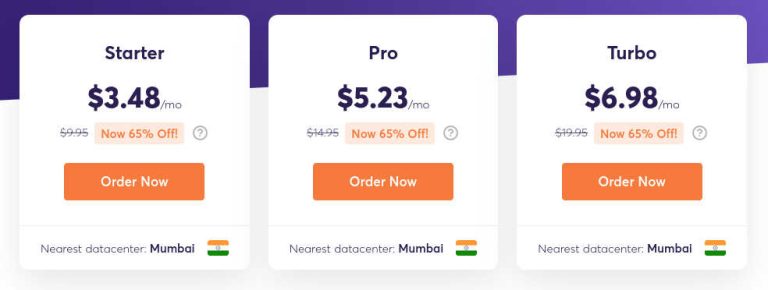
- Starter. This is the cheapest plan, but you can only host one website.
- Pro. This plan has more resources, and you can host multiple websites.
- Turbo. This is the most powerful package but also the most expensive.
How do you choose between them?
- My first choice would be Pro because it allows you to host multiple websites. This gives you the flexibility to experiment with different blogs.
- If you are cash-strapped and you only need one blog, then go with Starter.
- If you want powerful features because you expect your blog to grow quickly, or you need extra features like an online store or membership site, then go with Turbo.
#2. Register Your Domain Name
Once you click ‘Order Now’ on your preferred package, you will be taken to a page where you can register your domain name.
Under ‘ Register a new domain‘, type in your preferred domain name and then click ‘ Check’, to see if it is available for purchase.

Many popular or short domain names are often taken, so keep trying until you find an available domain.
If you already have a domain name from elsewhere, click on the ‘I already have a domain’ tab and put in the domain name.
#3. Choose your billing cycle
After choosing your domain name, you need to choose the hosting period (billing cycle).
You can choose to host for a month, one year (12 months), two years (24 months), or three years (36 months).
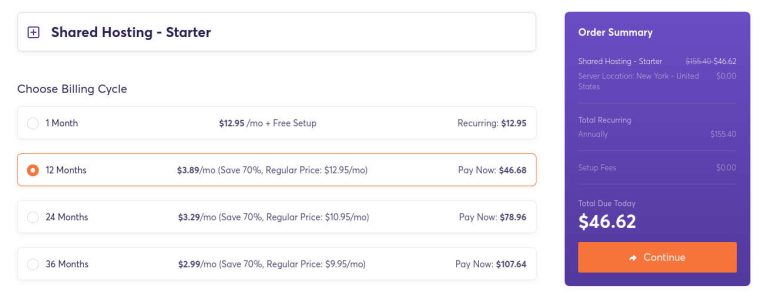
Note that the discounted prices will end once your current hosting period ends, and when you renew, you will be re-billed at the regular non-discounted price. And this can be a big jump in price, especially if you received a big discount.
Therefore, you want to lock in the discounts for as long as possible. ChemiCloud allows you to buy hosting at a discounted price for up to 36 months (3 years). In fact, you get an even larger discount if you choose a longer hosting period.
My advice would be to choose a hosting period of at least a year, and if you can afford it, go for the 3-year option.
#4. Enter a promo code and choose the server location
If you have a promotional code, you can enter it in this section.
You will then need to choose your server location. Choose a server location closest to where you think you will receive most of your visitors. This will ensure that they get the fastest server speeds.

For example, if you suspect that most of your visitors will come from the east coast of the US, choose the New York server.
ChemiCloud also offers the following add-ons.
- Protect your site with SSL.
- SpamExperts Email Security.
- Marketgoo SEO Tools.
You don’t need these because there are better options. Go with the default option ‘None’ for all of them.
Some alternatives to add-ons that ChemiCloud offer include:
- For SSL, you can install Let’s Encrypt SSL for free from your cPanel.
- For SEO, you can go KWFinder, which is affordable and has plenty of SEO features (check KWFinder prices).
- For email, you can go with a Zoho business email that will allow you to have a domain-branded email like contact@hobbyslave.com.
#5. Add Domain Privacy Protection
Add domain privacy protection. This is essential. This hides your private information (such as email and home address) from the Whois record directory. Anyone can access the Whois directory.
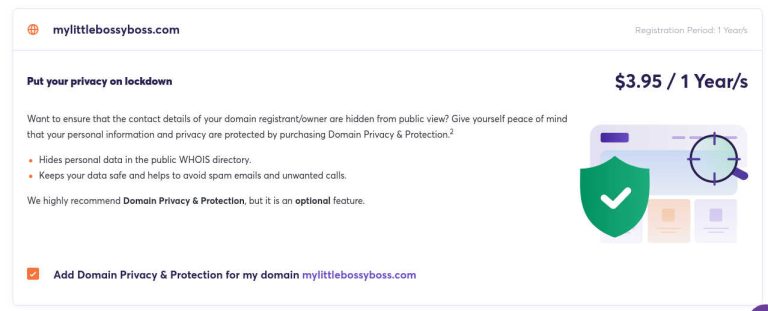
If you don’t do this, you will receive lots of spam calls, emails, and letters selling you all kinds of services. Privacy protection is quite cheap, and it will save you a lot of headaches.
#6. Fill in Your Account Information
In this section, you will need to fill in your account information.
Here is the information you will be required to fill in:
- Your personal information (first name, last name, email, and phone number). Fill in the correct information because the contact details you provide will be used to contact you.
- Your billing address (street address, city, postcode, country).
- Your account security (your password and security question). You will use this password when you log into your ChemiCloud account.
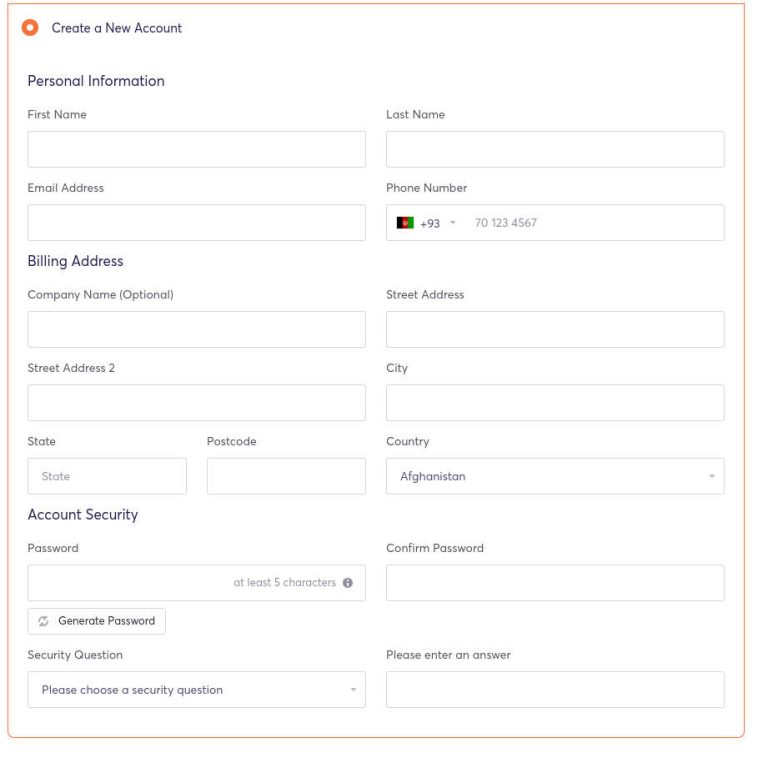
#7. Select Payment Method and Check Out
You then need to select your payment method. ChemiCloud has two options (credit card and Paypal).
Fill in your payment detail, accept the terms, and check out.
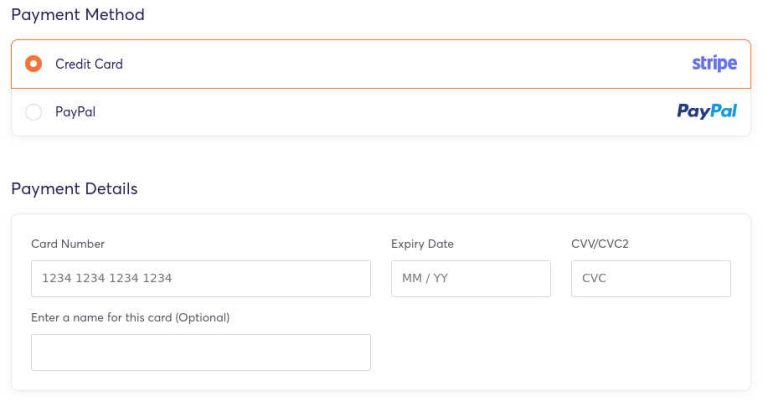
Once you have completed the signup process, ChemiCloud will send you several emails through the email address you provided.
These welcome emails will have useful information such as:
- Your receipt and billing cycle (including your next due date).
- Your login details.
- A link to the login page.
- Your server information (including your nameservers). If you did not buy your domain name from ChemiCloud, you will need the nameservers to connect your domain name to your hosting account).
Keep these welcome emails where you can easily access them.
If you encounter problems during the signup process, ChemiCloud have a chatbot that you can use to get instant access to someone to help you. They respond pretty fast.
Step 6: Install WordPress
To install WordPress, you will need to log into your ChemiCloud account. You can use the link provided in your welcome email. Alternatively, you can go to the ChemiCloud website, and on the homepage navigation, there is a red login button.
When you click the button, you will be taken to a login page (see below). Use the email address and password that you provided when signing up.
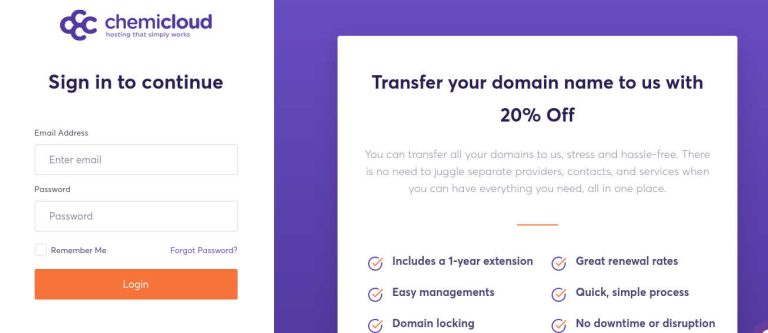
Once you log in, you will be taken to a client area where you can see your account details.
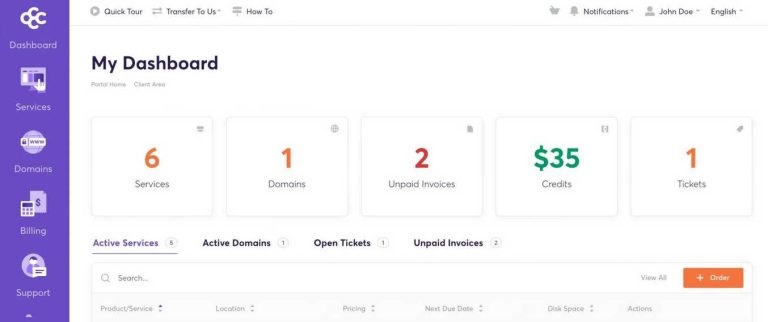
#1. Installing WordPress
To install WordPress, navigate to the cPanel from your dashboard (under active services). cPanel may require you to put in your password again.

Once in the cPanel, scroll down to the software section and click on WordPress Manager by Softaculous.

This will take you to the WordPress Management tab on Softaculous. Click on the Install button.

Once the installer is running, you will be required to choose:
- The WordPress version. Install the latest version.
- Your installation destination. This is the URL (domain name) you want to install WordPress on.
- The directory where you want to install WordPress. It is best to have this blank so that WordPress is installed in the root directory. This will enable you to log in from yourdomain.com/wp-admin
- Your site name and site description. Fill in your blog’s name and what it is about.
- Your username and password. You will use this username and password every time you want to log into your WordPress site. Ensure that you have a strong password and choose a username that is hard to guess. Also, keep these somewhere safe.
- Your admin email. WordPress will use this email to communicate any information about your site.
Once your WordPress installation is complete, you can log into your WordPress dashboard by typing your website address into your browser with /wp-admin added to the end of it. For example yourdomain.com/wp-admin
This will take you to the WordPress login page.
You can also log in through your WordPress manager (i.e. cPanel then WordPress Manager by Softacoulous).
#2. Configure WordPress.
Once you have installed WordPress, you need to do some basic WordPress maintenance and configurations such as:
- Deleting pre-installed themes and plugins that you don’t need.
- Installing any updates that need updating.
- You can set a nickname to display publicly on your posts (under the users’ tab).
- Setting the Permalinks to Post name (under Settings then Permalinks tab).
Check out this short video on how to configure WordPress (7 minutes).
#3. Install an SSL certificate
An SSL certificate is important because it secures your visitors’ data by encrypting it. It also helps with rankings on Google.
If you don’t install an SSL certificate, browsers will send warnings to your visitors that your site is unsafe.
Fortunately, with ChemiCloud, you can install an SSL certificate for free using Let’s Encrypt SSL.
From the cPanel, scroll down to the ‘Security’ section and then click on ‘Let’s Encrypt SSL’.
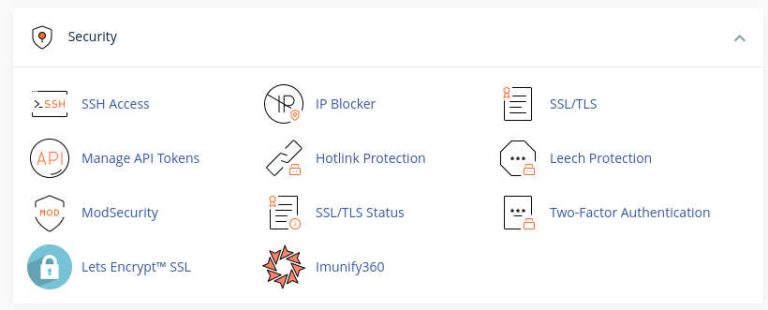
When you click on Lets Encrypt SSL, it will take you to a window where you can issue an SSL certificate.
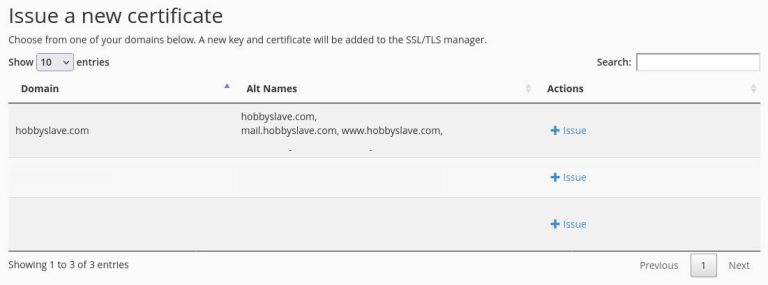
Step 7: Design Your Site
In the past, you had to hire a web designer to design your blog for you and this would cost on average between $1,000 and $5,000. These days, for under $100 you can design your site yourself and make it look really good using a WordPress theme and a blocks plugin.
WordPress comes already pre-installed with some free themes that you can use, but there are better themes out there.
A good theme you can consider is the GeneratePress theme. They have a paid and free theme.
The paid theme costs around $59 a year (check the current price) and is packed with useful features.
Why use the GeneratePress theme?
GeneratePress is one of the most popular themes (with over 4.5 million downloads). It is light, fast, and versatile. It is also quite affordable.
Here are some stand-out features of GeneratePress.
- A theme builder. This will help you create any kind of design you want such as a landing page, sales page, or e-commerce store.
- Site library. Here, you will find a collection of pre-made website templates that will speed up your design process.
- WooCommerce Integration. This is important if you want to create an e-commerce site.
To add even more functionality to the GeneratePress theme, you should use it together with the GenerateBlocks plugin (also made by the GeneratePress team). GenerateBlocks plugin adds custom functions to the native Gutenberg blocks on WordPress.
The paid plugin starts at around $39 a year (check the current price). They also have a free plugin.
How do you decide when to use the free or paid theme or plugin?
- If you are a general blogger who wants a beautiful, customizable site, go with the GeneratePress premium ($59) and the free GenerateBlocks. This will be sufficient for most customizations.
- If you want maximum customizability, use the GeneratePress Premium theme and GenerateBlocks Pro. Together, they should cost less than $100 a year. Choose this option if you are into web design, digital marketing, or e-commerce.
- If you are strapped for cash and just need a barebones blog without much customization, go with the free GeneratePress theme and free GenerateBlocks.
To install a free WordPress theme, go to your WordPress dashboard, ‘Appearance’ then ‘Themes’ then ‘Add New’. From here, you can search for any free theme on the WordPress repository. If you want the free GeneratePress theme, search for it in the search bar and then click ‘Install’ and then ‘Activate’.

To install a paid WordPress theme such as the GeneratePress Premium theme, go to the GeneratePress theme website and purchase the theme. They will give you a link to download the theme as a zip file.
Then go to Go to your WordPress admin dashboard then click ‘Appearance’, then ‘Themes’ then ‘Add New’ then ‘Upload’.
Navigate to the folder where you have saved the zip file and click upload. You will need to install your license key and then activate it.
If you go on YouTube, you will find many tutorials that will show you how to design your blog using GeneratePress and GenerateBlocks. For example, you can check out this tutorial.
Step 8: Install WordPress Plugins
WordPress plugins help you to add functionality to your site. For example, you can:
- Add e-commerce features like stores and membership sites.
- Add security features like login limits and hardening.
- Speed up your site.
- Add visitor tracking such as Google Analytics.
To add any free plugin (such as GenerateBlocks), go to your WordPress dashboard and navigate to ‘Plugins’ then ‘Add New’.

You can search for free plugins in the WordPress repository using the search bar. Once you find a plugin you like, click ‘Install’ and ‘Activate’.
If you want to purchase a plugin, go to the vendor’s website, purchase the plugin then download it as a zip file. Then go to your WordPress dashboard and click ‘Plugins’ then ‘Add New’. Then click ‘Upload Plugin’ and browse to the folder where you have saved the zipped plugin that you have purchased.
You will need to install your license key and then activate it.
Having too many plugins can slow down your site and lead to security issues, so it is best to start with a few and add new ones only when needed.
You can get free versions of the most essential plugins, although you get more functionalities and support if you go with a paid plugin.
Here are some great plugins you can start with on a new site.
- SiteGuarding (paid). This is a security plugin that protects your site from hacking and malware infection. You can also remove any malware if your site gets infected. Check out SiteGuarding here.
- WP Rocket (paid). This is a must-have plugin if you want to speed up your site. A slow blog can cost you visitors and rankings in Google. WP Rocket is cheap and easy to use. Check out WP Rocket here.
- Imagify (free and paid). This is an important plugin for reducing the size of your images automatically. Large images are a big cause of slow websites. Check out Imagify here.
- WP Vivid (free). This is a backup plugin and you can also use it for staging and migrating sites. You need to have a backup in case something goes wrong with your site. Always have your own backups for your site. Check out WP Vivid here.
- Payhip (free and paid). If you intend to sell any digital downloads on your site, Payhip will do all the heavy lifting for you (Check out Payhip here). You can get a 10% discount on the paid plans if you use the code HOBBY10.
For a deep dive into the most important WordPress plugins that you should install in your blog, check out my article on the must-have plugins for a new blog.
Step 9: Create Essential Pages
With a WordPress blog, you have the option of creating either Pages or Posts.
A page is used for content that does not change very often. Here are the important pages you need to create:
- Homepage. This serves as a hub for your content and introduces your blog.
- About page. This tells your visitors more about you.
- Blog page. This is where your visitors can find all your blog posts.
- Legal pages (privacy policy, terms, and disclaimer). These tell your visitors about what kind of data you collect and the terms of using your blog. You will need to have the legal pages in place if you want to apply to an affiliate program or a display Ads network like Ezoic or Adsense.
To create a page, go to your WordPress dashboard then navigate to ‘Pages’, then ‘Add New’.

Step 10: Create a Navigation Menu
To access your important pages, you need to create a navigation menu. Usually, the menu appears at the top of your website, but you can also have it at the footer.
You can add pages to your menu by going to your WordPress dashboard and selecting ‘Appearance’ then ‘Menus’.
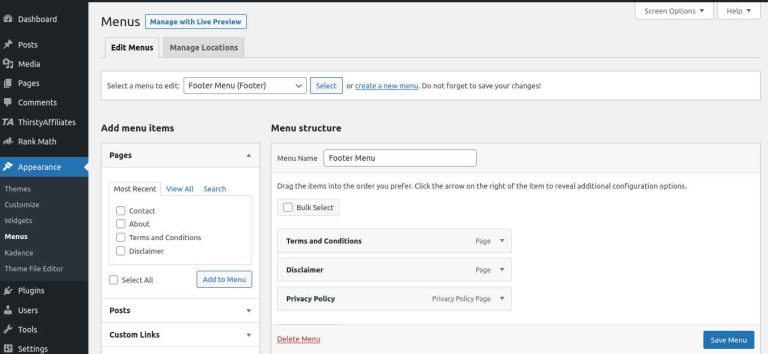
From the Menu pages, you can create a new menu, add pages to a menu, delete a menu, or specify where you want a menu to appear.
You can customize how your navigation menu looks from your GeneratePress theme.
Step 11: Write Blog Posts
A post contains information that changes often. It differs from a page in several ways. It has a post author and date of publication. You can also add comments to a post.
Most of the content you write on your blog will be in posts.
To create a post, go to your WordPress dashboard then navigate to ‘Posts’, then ‘Add New’.

Here are quick tips on how to write content.
#1. Write SEO-optimized content
Google is the biggest referrer of traffic to blogs, so learn all you can about SEO (Search Engine Optimization).
One powerful SEO technique is to target specific keywords that are easy to rank for on search engines like Google.
You can use a keyword tool like KW Finder to discover keywords with high traffic and low-ranking difficulty. Keyword tools can be pricey but KWFinder is one of the more affordable ones (check the current KW Finder price).
#2. Create high-quality content quickly
How fast you grow your blog depends on how fast you can write content. Create a schedule so that you can consistently create content.
Aim to write at least two posts a week. If you write for one or two hours a day, this is quite achievable (see a strategy to make a million dollars from blogging in under 3 years).
If you are working a full-time job or you are a parent, getting time to crank out lots of content can be difficult.
You can speed up your content creation by hiring writers in places like Fiverr or Upwork.
Alternatively, you can use an AI writer. AI has become really good since the release of GPT4 and Chat GPT. A good AI writer can write content better than most humans and does so in minutes.
A good and affordable AI writer you can try is Writesonic. It uses the latest AI features (such as GPT4) to create all kinds of content.
The Writesonic premium plan costs about $13 a month for 60,000 words (check the current price). At 60k words, you can write 30 blog posts that are 2,000 words long every month.
Writesonic also have a free plan that you can use to test how the AI writer works (you don’t need a credit card).
#3. Use images
Images are great for improving the readability of your content but also for SEO.
If you are not good at design, you can use a service like Visme to create your images. With Visme, you can easily create attractive featured images, logos, infographics, and graphs.
They have lots of templates and free images that you can use. And you can use their images without any copyright worries. Picking images randomly from Google can land you in trouble with the original owners of the images.
Visme is quite affordable, with the starter plan costing about $12 a month (check the current price). They also have a free plan you can use if on a budget.
#4. Fix grammar mistakes
Grammar mistakes can make your blog look unprofessional. Make sure you go through your blog post at least twice. It also helps to have someone else read it.
You can also use a tool like Grammarly. Grammarly uses AI technology to edit your posts and it is quite good. They have a free and paid option that you can try.
#5. Format your content for skimming
Ensure that your content is easy to read. When people come to your blog, they don’t want to see a wall of text. You should break up your text into manageable chunks using:
- Headings/sub-headings.
- Bullet-points and lists.
- Images.
Quick Tips About Starting a Blog
Here are some quick tips that could save you a lot of trouble later.
#1. Lock-in Discounted Prices
Most shared hosting companies offer discounted prices for first-time buyers. These discounts can be significant (sometimes up to 70%). The price will revert to the normal price on renewal. You can lock in these discounted prices by purchasing hosting for a longer period.
#2. Back Up Your Site
Although a good hosting company will back up your site for you, you need to have your own backups.
With your own backups, you can change hosting providers whenever you want. Usually, when you stop paying for hosting, the hosting company will delete your site and all backups from their servers.
If you have not transferred your site or backed it up before they do so, you could lose years of work.
You can use a plugin like WPvivid to back up your site. Ensure you back up your site off your web hosting company servers (for example, on your computer or a cloud hosting provider like Google Drive or Dropbox).
If you have only one site, you can use the free WPvivid, but if you have (or plan to have) several sites and you need support, better go with the paid version starting at $49 a year for 2 sites (check the current price).
#3. Consider a domain registrar
If you have only one domain, it is more convenient to register your domain with the hosting company. Some hosting companies (such as ChemiCloud) even give a free domain which is a plus.
However, if you have more than 2 domains, it is better to register your domains with a domain registrar. NameSilo is a great domain registrar you can use. They are affordable and they will give you free whois protection (check NameSilo Prices).
It becomes easier to manage and renew your domains from one registrar. Also, it is easier if you want to change hosting companies.
However, if you are a beginner with one site, let the hosting company do the domain registration for you, especially if you get a free domain.
Wrapping Up
If you have followed the steps I have provided, by now you should have your blog ready. Congratulations!
If that felt like drinking from a fire hose, don’t worry. Take your time and go through the steps again.
Once you successfully create your first site, then you will have the skills to create as many sites as you want. And the process will get even easier.
If you encounter any problems during the process, you can contact ChemiCloud through their chatbot, and they will help you. The customer care team is responsive and helpful.
Also, there are plenty of resources on YouTube for installing and using WordPress or GeneratePress. You can use these resources whenever you get stuck.
Once you have your site ready, I suggest that you read my article on the best blogging advice for beginner bloggers. In that article, I go into detail about all the lessons I wish I knew when I was starting out as a blogger. It will help you avoid simple beginner blogging mistakes.
Further reading
You might also enjoy reading the following articles.
